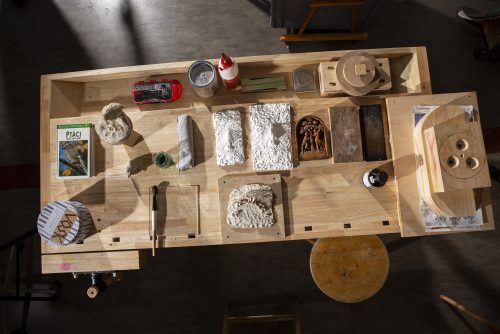
Max Freund
Blümchen
Project Info
- 💙 Ravnikar Gallery
- 💚 Piera Ravnikar
- 🖤 Max Freund
- 💜 Eva Simonič
- 💛 Mario Zupanov
Share on

Max Freund, "Blümchen", installation view, Ravnikar Gallery, 2023
Advertisement

Max Freund, "Blümchen", installation view, Ravnikar Gallery, 2023

Max Freund, "Blümchen", installation view, Ravnikar Gallery, 2023

"Blümchen", oil on canvas, 200x160cm, artist frame, 2022

Max Freund, "Blümchen", installation view, Ravnikar Gallery, 2023

Max Freund, "Blümchen", detail, Ravnikar Gallery, 2023

"dont sleep in my body", oil on canvas, 103x83,5cm, artist frame, 2022

"Skulptur im Park 1-8", oil, oil stick and collage on wooden panel, 64x100cm, 2022

"never saw a snake and a rat pair", oil on canvas, 250x180cm, 2022

Max Freund, "Blümchen", installation view, Ravnikar Gallery, 2023

"specimen 6" (revisited, landscape painter), oil, felt, paintbrush and paper on canvas, 121x86cm, artist frame, 2022
Max Freund's visual world is a distinctive exploration of the creative process itself. He is interested in all the components of the entire spectrum of artistic creation, particularly the work and the material. He gains something from every single creative process, regardless of whether or not it has "resolved" into a final result, i.e. a work of art: the process of production (also physical) is a constitutive factor of paramount importance. The repetition of a form or colour, specific compositions from pre-existing artworks, the repetitive reworking of these details into new works, and the cutting and reassembling of pieces of canvas and textiles, are emblematic of his practice, which can be characterised as a dialogue between the abstract and the figurative. The rhythm of both dictates the narrative and offers multiple points of view – literally and figuratively – simultaneously. Freund's paintings maintain the dualism of zooming in and zooming out; as one approaches the works, the depictions dissolve and the physical matter itself is of the essence. All the works are captured moments that challenge the resonance between the viewer and the outside world.
Freund is first and foremost a painter, but he often ignores the boundaries of this field and favours the material. He is interested in the autonomy of the material, its behaviour and its "receptivity" to the interventions the artist makes on it. Collecting materials from books, magazines, photographs, scraps of fabric and everyday objects is crucial; small, seemingly insignificant details are then sorted into the artist's private archive, which serves as a system of cross-referencing. The collected images are semiotically understood as pictograms of a larger system of signs that transcends the linguistic and cultural confines of the social backgrounds we come from, testing the viewer's knowledge of the references of music, pop culture, wordplay, fiction, media, etc. In this way, the artist creates a network of visual links, connections, clues, intermingled ideas, metaphors, symbols and feelings drawn from the host of images of the contemporary globalised world, which in turn establish a new sign system.
The current exhibition, Blümchen, is also a complex, ironic interplay of references. The starting point is a single word, a diminutive for flowers. Without analysis, the flowers seem sweet, simple and ordinary, a universal aesthetic symbol of naive and natural beauty, but Freund quickly turns things upside down: the diminutive carries undertones in certain German compound words (Blümchenkaffee, Blümchensex, Mauerblümchen) with very specific meanings often linked to very specific social contexts, which, on the one hand, are firmly embedded in Austrian and German culture, and on the other, transcend these cultural frameworks. Blümchen are not only little flowers, they also evoke Blümchen, the pop and Eurodance singer (from the 1990s), Blümchen Blau, the Austrian new wave band (from the 1980s), Benjamin Blümchen, the anthropomorphic elephant (an entertainment phenomenon since the 1970s). Some references remain enigmatic for those from outside the German-speaking world, while the understanding of others depends on other factors, such as the age of the viewer, his knowledge of art history or his involvement in internet culture. Despite the common recognisability of this sign, Freund shows that even without any knowledge, a connection is inevitable, perhaps precisely because of its universality, which conceals hundreds of layers of established meanings, cues and associations. Thus, flowers signify the triviality of the still life genre in art history, the moment of life and death, the normalised aesthetic of domesticity when taken from the natural environment and brought into the home, and in contrast, wild and untamed nature, widely identifiable Van Gogh's sunflowers, now exploited and available in every museum gift shop, the cliché and sarcasm in flower painting, decorativeness and pattern, desire and alienation, polite gesture and peace all at once.
Eva Simonič




